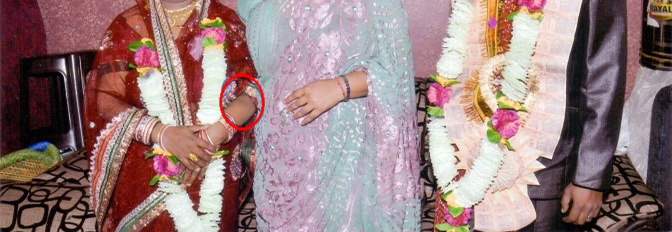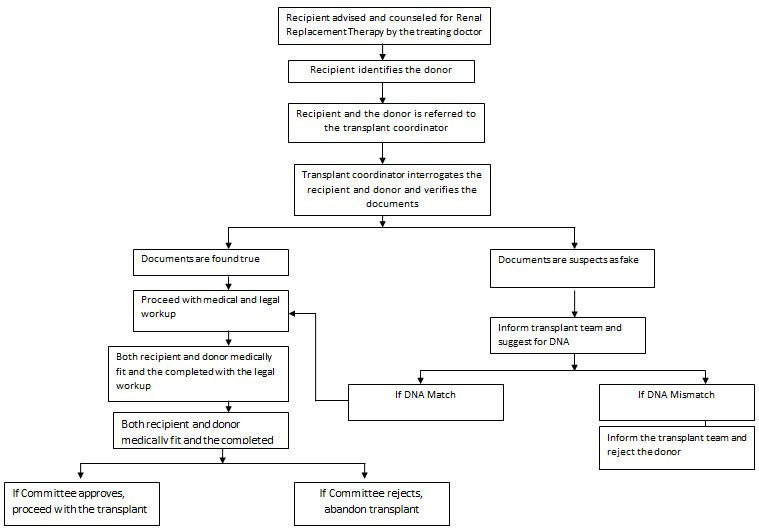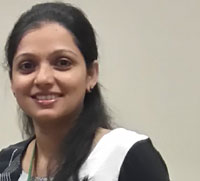Renal transplantation or kidney transplantation is the best treatment for a patient suffering from end-stage renal disease (ESRD). Compared with dialysis, a transplant leads to a longer and enhanced quality of life, and lesser cost for the patient and the health care system. People can receive kidneys for from Living and Deceased donors.
In India, the number of patients requiring organ transplant is increasing day by day. Unfortunately because few people donate organs after their deaths, deceased donor organ transplantation (DDOT) accounts for less than 4% of kidney transplants in India. This lack of availability of deceased organ donors is the main reason for the increase in living organ donations of Kidneys and Livers in the country.
In living donor transplants, as per the Human Organ Transplantation Act (THOA) and rules made in 2014, only 1st degree relatives, i.e grandparents, parents, siblings, spouse, children and grand children above 18 years of age are allowed to donate. However people may not have family members who are willing or able to donate.
Therefore, any cases we find that some of the donors are paid for donating their organs, and fake documents are made to suit the relationship they plan to present before the transplant team and the Human Organ Transplant Committee (Authorisation Committee/Competent Authority). If left unchecked there is mass commercialization of human organs, a full blown racket working out there, with all its structures and networks in place. This then reinforces the need for a meticulous assessment of each case that is brought up for a living donor transplant.
Below are some of the interesting case studies of fraud and deception in organ transplants, and how they were detected. Following that are steps that Transplant Coordinators can use to ensure that it doesn’t happen in their hospitals.
Case Studies involving forged documents and how they were detected
Case 1 – Faking Marriage
Mrs. X came to the OPD with Chronic Kidney disease with Mr. X as donor. Both of them were accompanied by three men, out of which one they were claiming to be their brother-in-law and the others as Mr. X’s friends. During the interrogative session, Mrs. X said that as she theirs was a love marriage, none of the family members were in good terms with them.
In the meanwhile till the surgery could be fixed, Mrs. X was advised to undergo dialysis in the transplant centre itself. They were also asked to produce documents such as the voter ID card, Marriage certificate, Ration card and Bank account passbook for the joint account they claimed to have. During the verification, the transplant coordinator had doubts on the marriage certificate and the voter ID card of the donor, so the coordinator asked them to produce their marriage photographs and old family photographs.

The patient took a week’s time to get the photographs. Meanwhile, the transplant coordinator also noticed that whenever Mrs. X came for the dialysis, she was accompanied by another man, who was not introduced to the transplant team. When the transplant coordinator enquired about the man who accompanied Mrs. X for dialysis, it was told that he is her husband’s friend. Here the doubts of the transplant coordinator get stronger. When the photographs were produced the transplant coordinator could notice in the marriage photograph a fistula on Mrs. X’s left arm. Keeping that in mind, she enquired as to when the marriage took place. Mrs. X replied 10 years. To the next question as to when the fistula was prepared, the answer was around 6 months back.
Here the transplant coordinator successfully prevented a paid donation as it was proved that the man accompanying Mrs. X for dialysis was her real husband and they had three kids. The ‘fake’ husband was a paid donor.
Case 2 – Transplant Coordinator acts as a detective to prevent paid donations
Ram along with his father Pratab and stepmother Laxmi came to the hospital for the renal transplant of Ram. Laxmi was the donor. The outfit and body language of the stepmother was pointing towards the fact that she could be a paid donor. With that suspicion an extensive with Ram, Pratab and Laxmi was done by the transplant coordinator. Laxmi was not able to answer any of the questions which were asked about her husband, siblings or parents. The transplant coordinator verified the details in the documents based on the history they had provided. It was found that there was a mismatch between the date of issuance of the Laxmi’s ‘Aadhar’ card and the date of marriage. The Aadhar card clearly mentioned the name of Laxmi’s husband and was issued a year before the date of marriage as recorded under the marriage certificate.
When this was asked, Pratab replied that Laxmi does not have any relatives and hence the ‘Aadhar’ card was made with those details. To prove the relationship further, the transplant coordinator asked for the family photographs, which were immediately shown. The father’s head appeared larger in size when compared to his body and this proved that the photograph was edited. Organ trading was prevented once again by an alert Transplant Coordinator.
Case 3 – Faking A Relationship
Ms. A, an international patient approached the hospital for a renal transplant with her cousin brother as donor (mother’s sister’s son). The husband and the facilitator (a person who brings and guides an international patient) were accompanying the patient for the first visit to the hospital to meet the doctor. It was informed that the donor was resting in the guest house. So the doctor started the medical workup of the patient and asked the family to bring the donor to start the process. The facilitator and the donor came to the hospital separately saying that the patient is tired and taking rest in the guest house.
The Transplant Coordinator asked for the legal documents and interviewed the donor and the patient separately. The husband of the patient had the same blood group, but he had given some lame excuse for not donating to his wife. The patient was carrying a HLA report which reported a 100% match with the donor. The HLA report created a suspicion in the mind of the transplant coordinator for the fact that rarely does an HLA report match 100% with a cousin. The donor and the patient were answering questions confidently and giving similar answers. The documents were true according to their statement. The documents which they provided were looking original and the Embassy had also attested the documents.
The donor and the patient were asked to complete the remaining work-up process together. The behavior of the patient and the donor created further suspicion in the mind of the transplant coordinator. The transplant coordinator then sought the help of team members to observe them keenly.
This seemed to be a foolproof case – all documents were produced and none of them seemed fake (or at least there was no way to verify the veracity of the documents in India), HLA showed a 100% match and their answers to all questions were same. The only way to prove the relationship was through a DNA test. The DNA results proved that the claimed relationship of kinship was false.
It was interesting to note that as soon as the DNA report was shared, the patient and her husband tried to wriggle out of the situation by saying that the donor was the son of the step-sister of the patient’s mother. And moreover, they claimed that the donor’s wife was pregnant and the donor had to go back to his native country.
Needless to say, the transplant never took place.
Case 4 – Tried my luck
Mr. K was advised transplant by a doctor in some other hospital. Mr. K and his daughter approached the transplant coordinator at the hospital where the transplant coordinator was working for the transplant. They claimed that the donor was the son-in-law of Mr. K. The donor had married Mr. K’s daughter two years back. The appearance of the son-in-law was in total contrast to that of Mr. K and his daughter. The donor appeared to be from a poor background when compared to Mr. K and his daughter. They claimed that the donor and Mr. K’s daughter had a love marriage. And since the donor’s parents were against this marriage, he was staying with Mr. K. The donor was taking care of the business of Mr. K. To every question, the donor answered that ‘the patient is my father-in-law and I don’t want my wife to donate’.
On further questioning, Mr. K started shouting at the transplant coordinator stating that he was a police officer and that he can produce whatever documents that maybe required. They had to be forcibly removed from the hospital. Finally, the patient underwent the transplant surgery with his daughter as the donor.
Case 5 – HLA Proven Brothers
An elder brother required a transplant with the younger brother as donor. The father of the patient approached the transplant coordinator with the documents. They had initially carried out the work-up with some other hospital. The father said that they did not go ahead with the transplant in the previous hospital as they were not happy with the services there. The elder brother is an engineer in a Public Limited company. He is married and lives in a metropolitan city. The younger brother is a contract labourer. The parents of the patient are well educated. The HLA between the donor and the recipient done at the previous hospital lab showed a 75 % match. The medical workup was complete from the previous hospital.
Accordingly, after consulting with the transplant team doctors, they were advised to repeat the HLA from a different lab. The HLA result was the same as that of the initial hospital’s lab. The transplant coordinator of the current hospital contacted the transplant coordinator of the patient’s previous hospital to find out the reason why the patient had left that particular hospital. Nothing in particular came out of this enquiry.
So the father of the patient was asked to produce the documents for verification. The driving license of the donor looked fake prima-facie and the mark sheet produced showed that the patient and the donor had the same marks in all subjects. However, the father of the donor remarked that the donor was not as intelligent as the patient.
Based on the doubts that began cropping up, the patient and the donor were asked to undergo a DNA test. The father was told that if the relationship is not true, even if HLA proves the kinship, the DNA will not. Understanding the gravity of the situation, the father agreed that the patient and the donor were not real brothers and the donor was a paid donor.
As Sir Arthur Conan Doyle quoted in his famous detective series, “My name is Sherlock Holmes, it is my business to know what other people do not know, a transplant coordinator will need to know all minute details to do the job diligently and honestly.
Summary
Ignoring the verification of documents can lead to legal complications for the transplant team, the hospital authorities and the committee members. In view of the above, each centre conducting organ transplants will have to set-up a clear process protocol for medical and legal work-up.
In India, since the law is very stringent and donors are not easily available, we need to bring in standard mechanisms to monitor and control the whole process of organ transplantation by appointing qualified and well trained transplant coordinators.
Note: All names given in the cases have been disguised and different names mentioned, to protect their identity.
Assessment for Transplant Coordinators
The assessment starts from the time the donor and recipient is introduced to the transplant coordinator. Here, the transplant coordinator assesses them by their appearance and body language. Occasionally in a case where organ trading may be happening, the suspicion starts at this point. After the initial introduction and pleasantries, it is ideal to interview the donor and recipient separately before calling them together for a joint meeting.
These separate sessions could cover the following points: –
a. Understanding the educational background of the donor and the recipient
b. A thorough interrogation in a casual and friendly manner around the following areas could be helpful: –
- Details and names of other family members and their relationship
- The house in which all of them are staying – living together or separately
- Details of servants, drivers etc. they employ
- What do they enjoy the most – hobbies, sports etc.
- Which school did they study ? Grades in school/ college?
- What was their desired profession?
- Who is their favorite star, politician etc.?
(This list should be of at least 20 questions and a select 5 to 10 should be asked and it should be different for each pair)
c. Income details of the recipient, donor and other family members
d. Is there affection and attachment between the family members?
e. The reason for donation and the motive behind the decision to be assessed before taking them further for any psychological evaluation.
The transplant coordinator has to take special care to corroborate and cross verify the details as given by the donor, the recipient and other family members, to judge the accuracy of the data as provided by the various sources. This will then give adequate support for understanding whether the donation is between legally valid pairs (donor-recipient), or it is a commercial deal.
After the session, documents should be verified that include:-
a. Voter ID card
b. Aadhar Card
c. Ration card
d. Marriage certificate if applicable
e. PAN card
f. Passport
g. Driving License
h. Any other
If the transplant coordinator is not satisfied with the documents provided, then the patient and the donor are asked to produce more details.
Some other documents will also prove to be crucial:-
a. Photo album – photographs with the donor and the recipient. To look at the background of the photograph, asking the recipient and donor to identify the members in the photograph, whether any editing has been done or not etc.
b. Birth certificates of the family members – Birth certificate of the children when the donation is between husband and wife, the quality of the paper that the certificate is printed on, whether the document is properly authorised and the place, date and the person who has issued the certificate.
c. Bank statements – in case there is a joint account in the name of the husband and wife, then the date of opening the account, transactions done etc. For the other than near relative (as given in Human Organ Transplantation Act (THOA) and rules made in 2014 there under), the transplant coordinator verifies the details of last three years.
d. Marriage certificate- Date and place of marriage and issuance of the certificate
e. Verification letter from the MLA/ Panchayat Sarpanch/ Tehsildar/municipal councilor to prove the relationship in depth especially in case of spousal donation.
The transplant coordinator correlates the details mentioned in the documents and those provided at the time of interviews. The scrutiny doesn’t end with the first visit, it is a continuous process. If the transplant coordinator has any suspicion after the verification of the documents, the transplant team is informed about the findings and recommends for a DNA test from a NABL accredited Lab. After the thorough verification shows that the details are correct, the case is referred for medical and the legal workup.
The transplant coordinator verifies that the documents which are provided by the recipient and the donor and in view of the documents and the DNA test result, the recipient and the donor is recommended for transplant to the Authorisation committee or the case is rejected.
The approval from the Authorisation committee/ Competent Authority is essential before proceeding with an organ transplant.
Flow chart on how to verify documents




This is so great I think others could benefit from learning about it. I am also a proud donor.
Thanks a lot for sharing with us
Trilly Rachel Mathew is a very valuable member of organ donation movement in India. Thanks to her.
Surely I will do..My organ donate
Great article Trilly – and very very useful.
Thank you very much for writing on this issue. As it is a very difficult task to identify the mal-practises in this field. In our country, it’s not tuff to make fake documents. In the private sector, the condition is far better than the government hospitals. The coordinators from the government hospitals are largely untrained and have very fewer resources. So, in such cases, it is also difficult to chase such people. ……
Tushar Savarkar
Coordinator, Regional Authorisation Committee, J J Hospital, Mumbai.
Trilly rachel mathew
Great article , an eye opener
Hi Mr. Savarkar,
we only need to know the history of the patient and correlate with documents
Thank you all for sharing valuable comments….
Thank you very much for writing this article. Please clarify if can we apply police verification must for all near relative & non near relative cases.